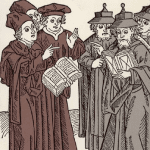Birthday of Philip Glass, 1937
On This Day in Jewish History: January 31, 1937
Philip Glass was born in Baltimore, Maryland. His family were Jewish immigrants from Lithuania. He would go on to be one of the most accomplished and ground-breaking figures in contemporary music, composing works for opera, symphony, concerto, string quartet and chamber music.
His musical education began as the son of a record store owner and continued in Chicago, where he attended the University of Chicago, and then at the Julliard School of Music in New York. But perhaps his most formative experience began with a Fullbright Scholarship to study in Paris where he worked with the renowned teacher Nadia Boulanger. In Paris, Glass was introduced to the full spectrum of post-war European avant-garde culture, including the film French New Wave and the experimental theater of Samuel Beckett. From there he travelled to India where he was influenced by the rhythms of its music and the stylings of Ravi Shankar.
The music of Philip Glass has been termed minimalist but, in fact, his compositions are rich and complex. His compositions for piano, vocal and orchestral performance rely on repetitive structures that slowly introduce subtle variations of notes and patterns that present minute shifts in mood and intensity. His repetitive structures can evoke darkness, anxiety and revelation and, at points, travel between classical, jazz and experimental fusions. His artistic circle in the United States has included painters, filmmakers and poets at the center of postmodernist culture. But he has consistently drawn on the masters of modernism as well, including Jean Cocteau and Franz Kafka. Glass’s music has reached a wider audience through collaborations with rockers such as David Byrne, Brian Eno and Mick Jagger.
He has also, since 1982, composed scores for many films, most notably in collaboration with documentarist Errol Morris. Few artists, in fact, have created musical connections with so many cultural forms, creating a catalog of work as broad as the artistic world.
Sources & Further Readings:












